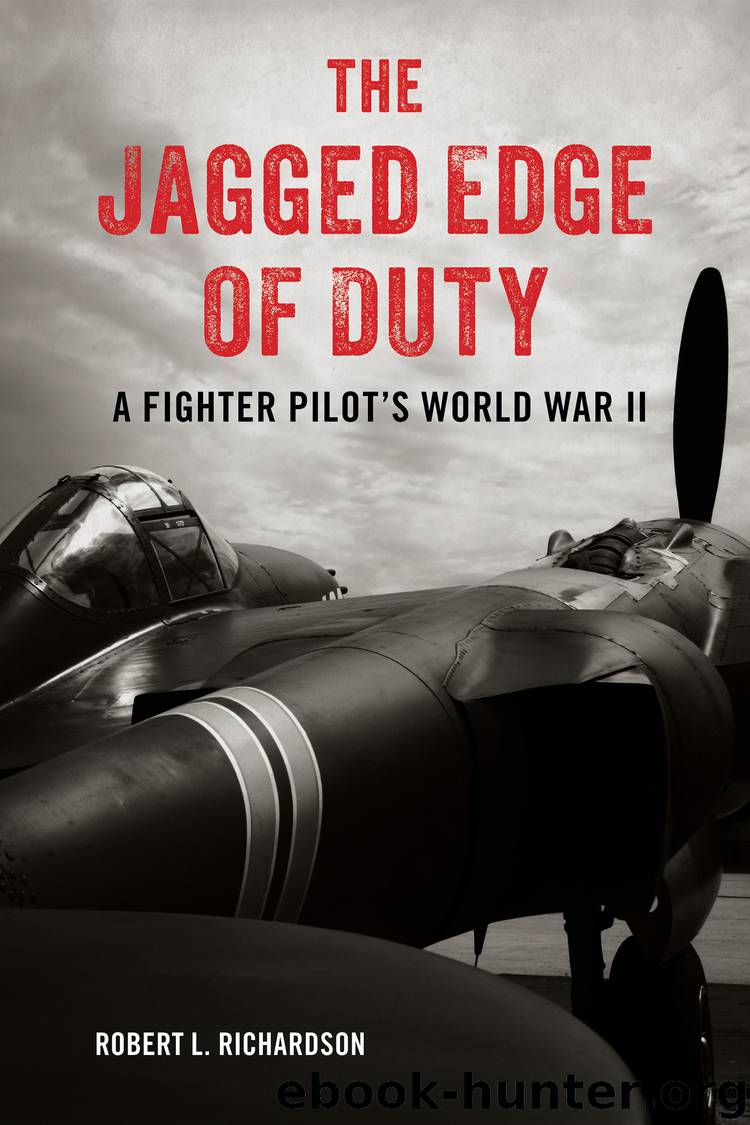The Jagged Edge of Duty by Robert L. Richardson

Author:Robert L. Richardson [Richardson, Robert L.]
Language: eng
Format: epub
Publisher: Stackpole Books
Published: 2017-03-16T16:00:00+00:00
Capt. Richard Decker, upon receipt of the Distinguished Flying Cross.
National Archives
The melee above Decker continued, with the P-38s continuing to engage the enemy interceptors and protecting the bomber formation. Pilots Manlove and Evans each shot down an Me 109, and Gregory, Boatman, and Bland each had a probable kill. Kocour, flying as Bland’s wingman, would have been in on the chase to confirm the “probable.”
The bombers continued their escape, with the 49th’s P-38s continuing to fight off the enemy attackers. Decker’s four-plane flight included pilots Richard, Manlove, and Boatman. As Decker’s plane hit the water, these three pilots circled his location, recorded the coordinates, and provided cover against the superior numbers of German aircraft that were still pressing their attack. Finally, thirty minutes after his downing, the cover pilots were running low on fuel and were forced to return to their base in Tunisia. Captain Trollope, with Lieutenant Knepper on his wing, heard of Decker’s loss and attempted to locate him, but was not successful. Gregory reported that the radios were not operating well that day, and the rest of the squadron was unable to give any close support to Captain Decker because they had lost sight of him.
The 49th’s P-38s returned to base at 1050, and four hours later, a new mission formed up to recommence the search. Eight P-38s, piloted by Trollope, Richard, Bland, Manlove, Gregory, Grant, Lovera, and Hoke, took off from Telergma at 1415. The pilots relocated Decker, just to the west of Egadi Island, waving a distress flag. He appeared to be uninjured, and Trollope contacted the air-sea rescue service to request a pickup. But due to the lateness of the hour, the rescue could not be effected.
The next day, June 21, a second rescue mission was launched by the 49th at 0550. Led by Lieutenant Gregory, it included pilots Foster, Leikness, and DeMoss in the first flight, with Lovera, Homer, Neely, and Boatman in the second. Decker was again sighted in his dinghy at 0745, having spent the night in open water. Food and water were tied to a life vest and dropped to Decker. One of the P-38s was sent back to secure aid from the air-sea rescue service, while the remaining seven aircraft maintained patrol over Decker. Fuel again became an issue for the patrol, and planes were relayed back to friendly bases to refuel. A single-engine floatplane, a British “Walrus,” was led back to Decker’s location, landed, and brought Decker aboard. He was taken to the 97th General Hospital in Tunis, in good condition. Decker’s rescuers returned to base at 1510—a ten-and-a-half-hour mission, and the end of a grueling two days.
On his return, Decker took some ribbing from his friends in the squadron. Harper remembers: “Goddammit, Decker, if I’da been with you, I wouldn’t have let you do that. Lieutenant Knott saw Decker get shot down, and this was Decker’s story: We were in this flight, and my turbo blew up. And Knott said, Yeah, that guy who was right on your tail is the one who blew it up.
Download
This site does not store any files on its server. We only index and link to content provided by other sites. Please contact the content providers to delete copyright contents if any and email us, we'll remove relevant links or contents immediately.
| Afghan & Iraq Wars | American Civil War |
| American Revolution | Vietnam War |
| World War I | World War II |
Waking Up in Heaven: A True Story of Brokenness, Heaven, and Life Again by McVea Crystal & Tresniowski Alex(37675)
Empire of the Sikhs by Patwant Singh(22974)
We're Going to Need More Wine by Gabrielle Union(18969)
Hans Sturm: A Soldier's Odyssey on the Eastern Front by Gordon Williamson(18485)
Leonardo da Vinci by Walter Isaacson(13184)
The Radium Girls by Kate Moore(11921)
Tools of Titans by Timothy Ferriss(8218)
Educated by Tara Westover(7941)
How to Be a Bawse: A Guide to Conquering Life by Lilly Singh(7393)
Permanent Record by Edward Snowden(5738)
The Last Black Unicorn by Tiffany Haddish(5558)
The Rise and Fall of Senator Joe McCarthy by James Cross Giblin(5229)
Promise Me, Dad by Joe Biden(5087)
The Wind in My Hair by Masih Alinejad(5034)
A Higher Loyalty: Truth, Lies, and Leadership by James Comey(4845)
The Crown by Robert Lacey(4723)
The Iron Duke by The Iron Duke(4292)
Joan of Arc by Mary Gordon(4014)
Stalin by Stephen Kotkin(3875)
